
The Malabar lark, or Malabar crested lark is a species of lark in the family Alaudidae found in western India.

The Karnala Bird Sanctuary is located in Panvel Taluka of Raigad District, outside Mumbai, India near Matheran and Karjat.It is the first bird sanctuary in Maharashtra. The sanctuary is quite small with an area of 12.11 square kilometres but is, along with the Sanjay Gandhi National Park and Tungareshwar Wildlife Sanctuary, one of the few sanctuaries to be within reach of the city of Mumbai.
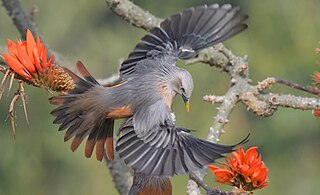
The chestnut-tailed starling, also called grey-headed starling and grey-headed myna is a member of the starling family. It is a resident or partially migratory species found in wooded habitats in India and Southeast Asia. The species name is after the distribution of a former subspecies in the Malabar region. While the chestnut-tailed starling is a winter visitor to peninsular India, the closely related resident breeding population with a white head is now treated as a full species, the Malabar starling.
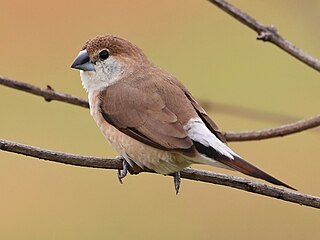
The Indian silverbill or white-throated munia is a small passerine bird found in the Indian Subcontinent and adjoining regions that was formerly considered to include the closely related African silverbill. This estrildid finch is a common resident breeding bird in the drier regions of the Middle East and the Indian Subcontinent. It has also been introduced into many other parts of the world and has become established in some areas. They forage in small flocks in grassland and scrub habitats.

The Malabar large-spotted civet, also known as the Malabar civet, is a viverrid endemic to the Western Ghats of India. It is listed as Critically Endangered on the IUCN Red List as the population is estimated to number fewer than 250 mature individuals. It has not been recorded during surveys carried out between 1990 and 2014. In the early 1990s, isolated populations still survived in less disturbed areas of South Malabar but were seriously threatened by habitat destruction and hunting outside protected areas.

The fungoid frog or Malabar Hills frog is a colourful frog found on the forest floor and lower vegetation in the Western Ghats in south-western India from Bombay to Kerala. It is very similar to another species with which it overlaps partly in range, Hydrophylax bahuvistara which extends further into parts of central India. Although restricted in range within peninsular India, they are of least conservation concern. Their upper parts vary in colour from brownish-red to bright crimson.

Chalcides pentadactylus, or five-fingered skink, is a species of skink found in the Western Ghats of India. Females of other species of the genus are viviparous, meaning that they give birth to live young. Almost nothing is known of C. pentadactylus. It is only known from the holotype which is lost [ fide Smith 1935]. Due to the loss of the only known specimen the true identity and origin of this skink, and its correct generic assignment, must await the examination of fresh material.
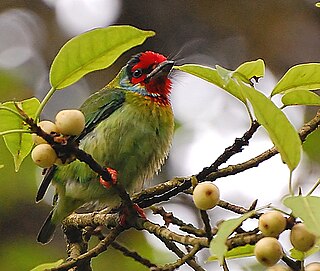
The Malabar barbet is an Asian barbet native to the Western Ghats in India. It was formerly treated as a race of the crimson-fronted barbet. It overlaps in some places with the range of the coppersmith barbet and has a similar but more rapid call.

Madayi. is a Census Town and Grama panchayat in Kannur district of Kerala state, India. Bhagavathy shrine, Madayi Kavu where devotees worship Bhadrakali, is located here. The Goddess is one of the family deity of the Chirakkal Royal family, and the temple is known for the Koyikalasham. The temple was one of the few to survive desecration by the armies of Tippu Sultan, which devotees attribute to the grace of the Goddess. The Kolathiri Rajahs were the administrators of the temple, however recently the administration was transferred to the Malabar Devaswom Board. Nearby is the Vadukunnu Temple dedicated to Shiva. The temple was razed by followers of Tippu Sultan in the 18th century, but the temple has been rebuilt and is a vibrant centre of religion in the region.

Idea malabarica, the Malabar tree nymph, is a large butterfly found in peninsular India. that belongs to the danaid group of the family Nymphalidae. It is found in forest clearings and above the forest canopy.

Myristica malabarica is a species of plant in the family Myristicaceae. It is endemic to the Western Ghats in southwest India. It is threatened by habitat loss according to the IUCN Red List. It can reach up to 25 m long and its bark is greenish black, smooth and sometimes reddish.

Polyalthia malabarica is a species of plant in the family Annonaceae and tribe Miliuseae. It is endemic to south-west India. It is threatened by habitat loss.

Rotala is a genus of plants in the loosestrife family. Several species are used as aquarium plants.
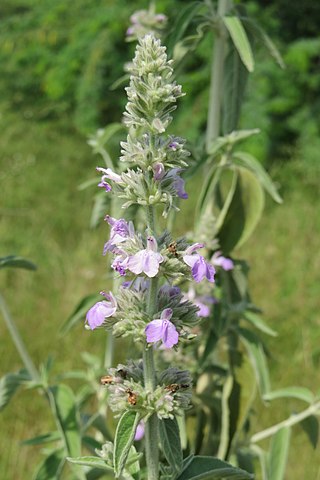
Anisomeles malabarica, more commonly known as the Malabar catmint, is a species of herbaceous shrub in the family Lamiaceae. It is native to tropical and subtropical regions of India, and Sri Lanka, but can also be found in Malaysia, Bangladesh, Myanmar, Bismarck Archipelago, Mauritius, Andaman Islands and Réunion.

The Day's round herring is a relative of the herring that is endemic to southwestern India. It is the only species in its genus. It is named after Francis Day who described the species in 1873.
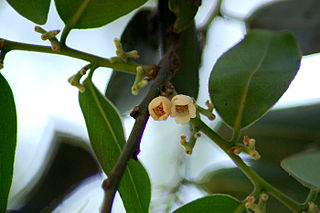
Diospyros malabarica, the gaub tree, Malabar ebony, black-and-white ebony or pale moon ebony, is a species of flowering tree in the family Ebenaceae that is native to the Indian Subcontinent and South East Asia.

Madayipara is a flat-topped hillock located in the Madayi, of Kannur district of Kerala state in the Southern India. It overlooks the town of Payangadi on the northern bank of Kuppam River.

Thryssa malabarica, the Gautama thryssa or Malabar anchovy, is a species of amphidromous ray-finned fish in the family Engraulidae. It is known as Balal parattaya බළල් පරට්ටයා in Sinhalese.
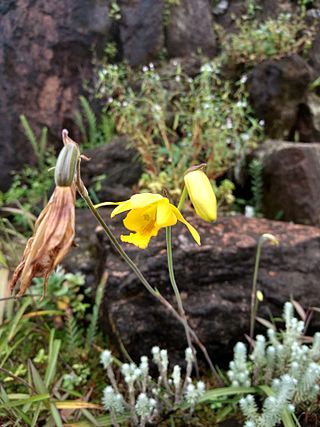
Ipsea malabarica, the Malabar daffodil orchid, is a species of ground orchids endemic to the high altitude hills of the southern Western Ghats in India. It was not seen in the wild for many years after its description and was rediscovered by K.S. Manilal in 1982 from Silent Valley. It is endangered and attempts have been made to propagate the species through tissue culture to reintroduce them into the wild.
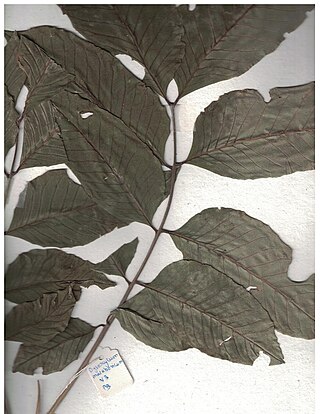
Dysoxylum malabaricum, or white cedar, is a tree species endemic to the Western Ghats, India. The species is considered Endangered under the IUCN Red List of Threatened Species.





















